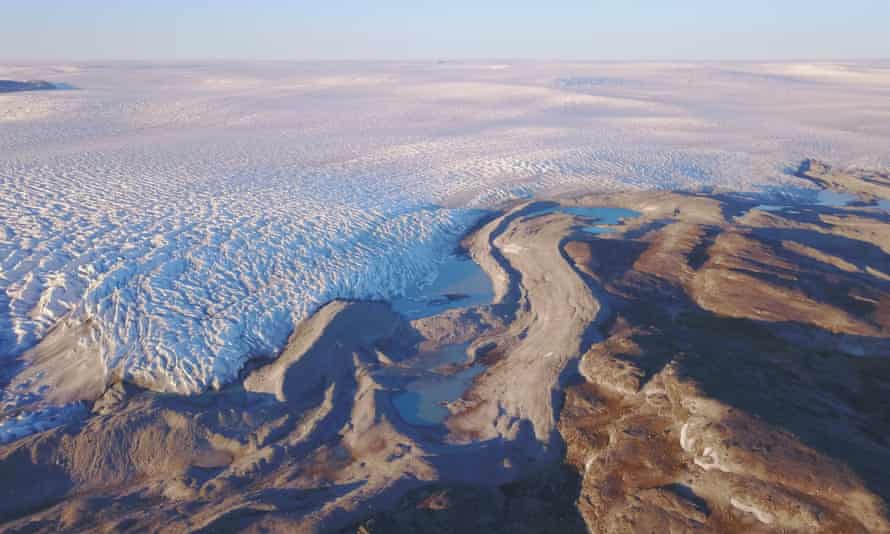Extract from The Guardian
Scientists say ice equivalent to 1-2 metres of sea level rise is probably already doomed to melt.

If the Greenland ice sheet were to melt completely, sea levels would eventually rise by about 7 metres.
A significant part of the Greenland ice sheet is on the brink of a tipping point, after which accelerated melting would become inevitable even if global heating was halted, according to new research.
Rising temperatures caused by the climate crisis have already seen trillions of tonnes of Greenland’s ice pour into the ocean. Melting its ice sheet completely would eventually raise global sea level by 7 metres.
The new analysis detected the warning signals of a tipping point in a 140-year record of ice-sheet height and melting rates in the Jakobshavn basin, one of the five biggest basins in Greenland and the fastest-melting. The prime suspect for a surge in melting is a vicious circle in which melting reduces the height of the ice sheet, exposing it to the warmer air found at lower altitudes, which causes further melting.
The study shows destabilisation of this ice sheet is under way. Uncertainties in the research meant it might already be at the point of no return, or be about to cross it in the coming decades, the scientists said. However, even if the tipping point was crossed, it did not mean that the entire ice sheet was doomed, they said, because there might be a stable state for a smaller ice sheet.
“We’re at the brink, and every year with CO2 emissions continuing as usual exponentially increases the probability of crossing the tipping point,” said Niklas Boers at the Potsdam Institute for Climate Impact Research, Germany, who conducted the research with Martin Rypdal from the Arctic University of Norway. “It might have passed [the tipping point], but it’s not clear. However, our results suggest there will be substantially enhanced melting in the near future, which is worrying.”
Boers said ice equivalent to 1-2 metres of sea level rise was probably already doomed to melt, though this would take centuries and melting the whole ice sheet would take a millennium. “We would probably have to drive temperatures back below pre-industrial levels to get back to the original height of the Greenland ice sheet,” he said.
“The current and near-future ice loss will be largely irreversible,” he said. “That’s why it is high time we rapidly and substantially reduce emissions from burning fossil fuels and restabilise the ice sheet and our climate.”
The new research examined just one part of Greenland, but Boers said there was no reason in principle that it should be different from other parts of the giant ice sheet: “We might be seeing something that is happening in many parts of Greenland, but we just don’t know for sure, because we don’t have the high-quality data for other parts.”
Media reports in August 2020 suggested the Greenland ice sheet had already passed the point of no return, but scientists said this was a misinterpretation of research. In 2019, scientists warned that the world might already have crossed a series of climate tipping points.
The new study, published in the Proceedings of the National Academy of Sciences of the United States of America, used temperature records, ice cores, and modelling to reconstruct the ice sheet’s elevation and melting rates since 1880. Careful examination of the size and duration of changes during this time series revealed the warning signals of an imminent tipping point, by showing that the ice sheet’s ability to recover from melting is diminishing fast.
The feedback loop caused by falling ice-sheet height appears to be the largest factor, but other feedbacks may play a role in destabilising it. These include the thinning of coastal glaciers, allowing more ice to slip into the sea, and reduced falls of fresh white snow exposing the darker surface of the ice sheet, which then absorbs more heat from the sun. But warmer temperatures may also result in damper air and more snowfall, counteracting some ice losses.
Boers said the dynamics of the Greenland ice sheet were very complex, and that using today’s incomplete knowledge to estimate a precise date when a tipping point is passed would give a false sense of certainty.
The scientists said better monitoring of the Greenland ice sheet is needed. “We urgently need to better understand the interplay of the different positive and negative feedback mechanisms that determine the current stability and the future evolution of the ice sheet,” said Boers.
Large-scale melting of the Greenland ice sheet would have long-term global consequences, beyond rising sea levels. It could halt the Gulf Stream ocean current, with potential knock-on effects on the Amazon rainforest and tropical monsoons.
“It’s great that we have satellites to track the pulse of our planet and models to perform a health check, but the diagnosis is shockingly clear: our climate is sick and needs urgent care,” said Prof Andrew Shepherd, at the University of Leeds, UK, who was not involved in the new study.
“Although we see the effects of climate heating around the planet, often the changes of greatest concern are those that will alter landscapes forever,” he said. “If Greenland has shifted into a new unstable state of heightened melting, then that’s big news.”
But uncertainties remained, Shepherd said, with some evidence that the heightened melting may have stabilised, which would be at odds with the idea that the ice sheet has entered an unstable state.
No comments:
Post a Comment